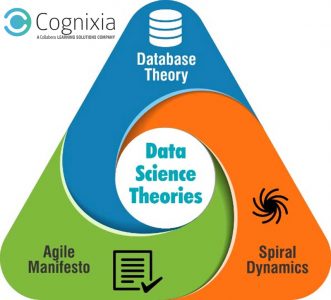Data Science Theories
One needs to understand various theories and principles before he can perform data science. Once learned, these theories and principles help you to understand a certain set of practices, and step by step skills applied by the data scientists. Whereas, overlooking these theories and principles stops you from understanding various data science practices. This post is intended to inform you about some important theories and principles of the data science environment.

-
Database Theory
Let us talk about the database theory first. This theory is intended to organize data and does so in a way that increases the efficiency of storing and retrieving processes. Data can be categorized into objects, further, these objects can be put into collections and these objects and collections can have relationships between each other and themselves. There is one aspect of this theory which you need to understand very clearly and that is the required effort of getting answers from the data which is directly proportional to the way you organize it. This means that a well-organized data-set will minimize your efforts and vice-versa.
-
Agile Manifesto
Second on the list is the Agile Manifesto. It is the set of principles which ensures high-quality outputs in environments subject to high levels of change and ambiguity. By adopting an iterative development process; these methods enable to overcome rapid changes and ambiguity. The Agile Manifesto utilizes self-managed teams and those who are passionate about technology are attracted to it in the similar way as scientists are attracted to the Big Bang. This principle works towards removing all cultural barriers between the developer, the client and the end-user. The focus of the Agile Manifesto is on using the latest technologies to make things simple. There is one aspect of Agile Manifesto that you must understand which is that all things tend to change and the more time you take to test your solutions in the live environment the higher is the risk of failure.
-
Spiral Dynamics
Spiral Dynamics is another theory which I would like to touch on. This theory concentrates on human development and behaviour, explaining what humans do and why do we do it? It provides explanations for several things like why we tend to leave the bed in the morning, what compels us to create things, and why do we constantly try to improve ourselves. The Spiral Dynamics Theory encompasses two mental states of “facts” and “values.” Facts are what we believe and these beliefs are a result of the acquired knowledge and our current environment. Values are usually defined as what we desire. These desires are driven by our intentions and concerns. These intentions and concerns branch from our knowledge and environment we live in; thus, completing a full circle. Spiral Dynamics Theory can be understood through a simple analogy i.e. our facts and desires come from the data which is presented to us.
Let us talk a little about Data Scientists now. Data Scientists are professionals who perform data science. They work on increasing the awareness, clarity, and direction for those working with data by using certain technologies and skill sets. The primary task which the data scientists perform is to accommodate the rapid changes occurring in today’s environment. Besides this, they also play an important role in minimizing the commotion which modern technology causes in our working, playing and learning environments. Data Scientists don’t just present data but they do it while creating an intelligence awareness of the results of presenting that data.
Data Science – How to Do It?
There are three components involved in data science – organizing, packaging and delivering of data. These are usually referred to by their abbreviated form – OPD of Data. Let us understand organizing first, it is the planning and execution of the physical location and structure of the data. Packaging involves the building of prototypes, performing statistical functions and creating visualizations. Delivering is where the story gets told and the value is obtained.
Having said that, we should also understand that the data scientists are quite different from other existing roles as they need to have a continued awareness of What, How, Who and Why? It is a professional imperative for a data scientist to know the output of the data science process and also, have a clear vision about this output at the same time. A data scientist should also know how to achieve the output within the limitations of available resources and time. A data scientist should also have a deep understanding of the people who will be involved in the creation of the output. Lastly, he should know why there is a motivation behind attempting to manifest the creative visualization.
All of the information shared above is just an outline of what the world of data science entails. It is a fascinating world with lots to understand, absorb and work on. This makes Data Science one of the most thriving career choices today. Huge volumes of data are being created every day and Data Scientists are the professionals with an ability to put this data to use. This makes them one of the most sought-after professionals in the world of technology.
Cognixia a Collabera Learning Solutions Company provides one of the best-rated training programs on Data Science which enables you to understand various aspects of the data science environment. Learning how to perform data science can take you places and can push your career on an upward trajectory.
Join Cognixia’s Data Science Training and be a part of this technology revolution. For more information, write to us or visit us at www.cognixia.com

